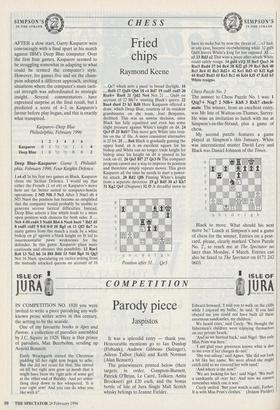SIMPSON'S
IN•THE-STRAND
SIMPSON'S
IN-THE-STRAND
CHESS
Fried chips
Raymond Keene
AFTER a slow start, Garry Kasparov won convincingly with a final spurt in his match against IBM's Deep Blue computer. Over the first four games, Kasparov seemed to be struggling somewhat in adapting to what could be termed the computer's style. However, for games five and six the cham- pion adopted a different approach, inviting situations where the computer's main tacti- cal strength was subordinated to strategic insight. Several commentators have expressed surprise at the final result, but I predicted a score of 4-2 in Kasparov's favour before play began, and this is exactly what transpired.
Kasparov–Deep Blue Philadelphia, February 1996 1 2 3 4 5 6 Kasparov 0 1 1/2 1/2 1 1 4 Deep Blue 1 0 1/2 1/2 0 0 2 Deep Blue–Kasparov: Game 5, Philadel- phia, February 1996; Four Knights Defence.
1 e4 e5 In his first two games as Black, Kasparov chose the Sicilian Defence. I would say that either the French (1 e4 e6) or Kasparov's move here are far better suited to computer-hostile operations. 2 Nf3 Nf6 3 Nc3 After 3 Nxe5 d6 4 NO Nxe4 the position has become so simplified that the computer would probably be unable to generate serious tactical difficulties. Instead, Deep Blue selects a line which leads to a more open position with chances for both sides. 3 ... Nc6 4 d4 exd4 5 Nxd4 Bb4 6 Nxc6 bxc6 7 543 d5 8 exd5 cxd5 9 0-0 0-0 10 Bg5 c6 11 Qf3 Bel In many games from this match a trade by a white bishop on g5 against a black knight on f6 led to insurmountable pawn weaknesses for the defender. In this game, Kasparov plays more cautiously and obviates this possibility. 12 Rael Re8 13 Ne2 h6 14 Bf4 Bd6 15 Nd4 Bg4 16 Qg3 Not 16 Nxc6, speculating on tactics arising from the mutually attacked queens on account of 16 Qc7 which nets a piece in broad daylight. 16 Bxf4 17 Qxf4 Qb6 18 c4 Bd7 19 cxd5 cxd5 20 Rxe8+ RxeS 21 Qd2 Ne4 Not 21 Qxd4 on account of 22 Bh7+ winning Black's queen. 22 Bxe4 dxe4 23 b3 Rd8 Here Kasparov offered a draw, which Deep Blue, courtesy of its resident grandmaster on the team, Joel Benjamin, declined. This was an unwise decision, since Black has fully equalised and even has some slight pressure against White's knight on d4. 24 Qc3 f5 25 Rdl? This move gets White into trou- ble on the 'd' file. A more consistent alternative is 25 b4. 25 ...Be6 Black is gradually gaining the upper hand. e6 is an excellent square for his bishop and White can no longer trade knight for bishop since his knight on d4 is pinned to his rook on dl. 26 Qe3 Bf7 27 Qc3 f4 The computer program cannot see a way to improve its position and therefore simply repeats moves. This gives Kasparov all the time he needs to start a power- ful attack. 28 Rd2 Qf6 Pinning White's knight from a separate direction. 29 g3 Rd5 30 a3 Kh7 31 Kg2 Qe5 (Diagram) 32 f3 A dreadful move to Position after 31 . . . Qe5 have to make but by now the threat of ... e3 had, in any case, become overwhelming while 32 gxf4 Qxf4 leaves White's king far too exposed. 32 ... e3 33 Rd3 e2 This wins a piece after which White could safely resign. 34 gxf4 elQ 35 fxe5 Qxc3 36 Rxc3 Rxd4 37 b4 Bc4 38 Kf2 g5 39 Re3 Be6 40 Rc3 Bc4 41 Re3 Rd2+ 42 Kel Rd3 43 Kf2 Kg6 44 Rxd3 Bxd3 45 Ke3 Bc2 46 Kd4 Kf5 47 Kd5 h5 White resigns.
Chess Puzzle No. 2 The answer to Chess Puzzle No. 1 was: 1 Qxg7+ Nxg7 2 Nf6+ Kh8 3 Rxh7 check- mate. The winner, from an excellent entry, was Mr Iste of Walton-on-Thames, Surrey. He wins an invitation to lunch with me at Simpson's-in-the-Strand, plus a game of chess.
My second puzzle features a game played at Simpson's this January. White was international master David Levy and Black was Daniel Johnson of the Times.
Black to move. What should his next move be? Lunch at Simpson's and a game of chess for the winner. Entries on a post- card, please, clearly marked 'Chess Puzzle No. 2', to reach me at The Spectator no later than Monday, 4 March. Entries can also be faxed to The Spectator on 0171 242 0603.


























































 Previous page
Previous page